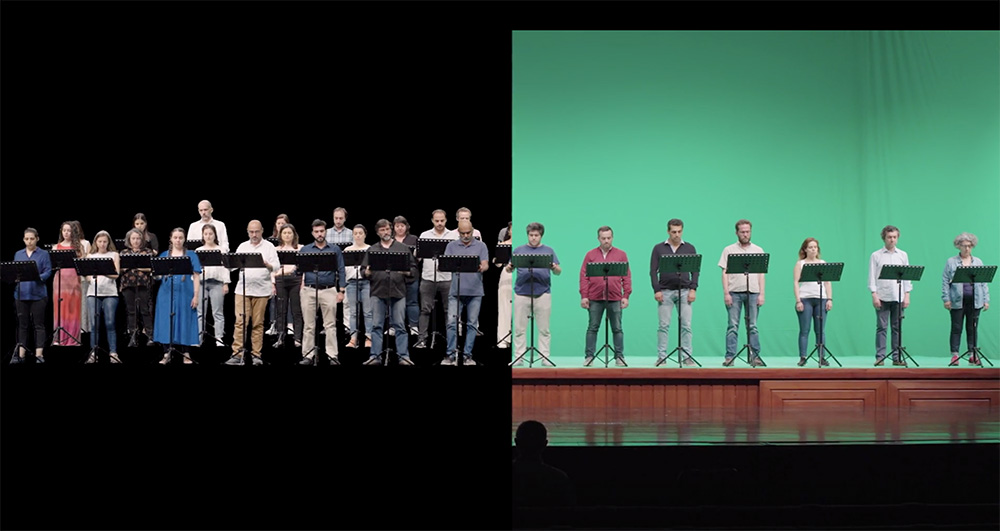May 2023 | Volume 24 No. 2
Cutting-Edge Choral
Termed a ‘tech cantata’, the piece features a live choir which vies for the audience’s attention with a virtual choir singing on a massive hologram screen behind them — the two groups both competing with each other’s performances and enhancing them. Said Professor of Music Giorgio Biancorosso, who staged the event: “The work raises new questions about the relationship between art and technology.”
Gulbenkian Música, a prestigious institution that is central to Portugal’s cultural life, commissioned acclaimed Hong Kong-based composer Dr Eugene Birman, from Hong Kong Baptist University, to write a work, and he chose the pandemic as the subject. Professor Biancorosso takes up the story: “Dr Birman approached me with his ideas, and in the fall of 2021 the Calouste Gulbenkian Foundation introduced us to prominent Portuguese writer Djaimilia Pereira de Almeida – virtually, via zoom of course! In response to our prompting, she wrote a beautiful, long poem dealing with the experience and legacy of the pandemic, especially the lockdowns, which had devastating effects on the performing arts scene in Lisbon.”
Summarising the original idea, he adds: “After so many months of watching live performances online, Dr Birman wanted to examine what it might mean to play a recording inside a theatre to a live audience. Hence the idea of a virtual choir singing to a live audience. It’s a brilliant premise, and immediately got me thinking about how to go about delivering it onstage.”
While references to the pandemic are an important part of the text, the three creatives agreed that they would not be too explicit to allow the work to remain fresh well after the memory of the pandemic subsides. The result is a provocative reflection on the passing of time during the lockdowns, peppered with references – some explicit, others ambiguous or even enigmatic – to the life of performing artists in Lisbon during the lockdowns.

Virtual choir (left) rendered on a 3D mesh hologram screen.
Tech cantata
“We came up with the term ‘tech cantata’ because it helps clarify that this is a large-scale vocal work and stresses the central role of technology in its creation and delivery,” said Professor Biancorosso. “You could say it’s a take on the old genre of the cantata, where soloists and a choir vie for your attention in ever changing permutations. But the really important quality of The Longest Days and the Shortest Days is that it sets up and feeds off the relationship between a live and a virtual choir – its avatar, in a sense – in ways that have never been explored so thoroughly and with such depth.”
Describing how the piece works, musically and visually, he added: “The virtual choir is both a substitute and a double: the singers are the same, and the relationship between the choirs is written into the score itself. The virtual choir is not a hologram in the strict sense but a high-resolution projection, based on a series of audiovisual recordings made in Lisbon in June 2022. The quality of the audio recordings is so high, and the playback system of the Gulbenkian Auditorium so fine, that it was impossible to tell the virtual and the live choir apart without the visuals.”
The mix of virtual and real also allowed Professor Biancorosso to have some fun with the staging. “The first movement was quite a gamble: asking a large audience to face what was in essence just a projection for 12 long minutes. But it paid off. Unlike the choir, the conductor walked onstage first, and bowed, complete with sound effects. But he too was virtual. When at the end of the movement he burst into a cloud of dust along with everyone else, the audience was very surprised and responded with huge, amused applause.”
Professor Biancorosso says he jumped at the opportunity to stage the work because of the brilliance of Birman’s premise and the resulting piece, and the resources and professionalism of the Gulbenkian Foundation. “I felt honoured to be working for them. Given the challenges the work presented, the support was nothing short of extraordinary, and the audience’s rapturous appreciation at the debut performance was thrilling. This whole experience strengthened my conviction that we need to rethink the question of art and technology.
“Technology has always been central to the presentation of musical and indeed theatrical performance. The challenge today is to channel new technologies in ways that resonate with contemporary audiences. To do that we need to move beyond the showcasing of expensive toys and put the human experience front and centre.”

Live soloists (right) rehearsing with the virtual choir.

Professor Giorgio Biancorosso (centre) and Dr Eugene Birman (left) at the colloquium ‘The Longest Days and the Shortest Days: A Dialogue on Art & Tech’.
The really important quality of The Longest Days and the Shortest Days is that it sets up and feeds off the relationship between a live and a virtual choir – its avatar, in a sense – in ways that have never been explored so thoroughly and with such depth.

PROFESSOR GIORGIO BIANCOROSSO

